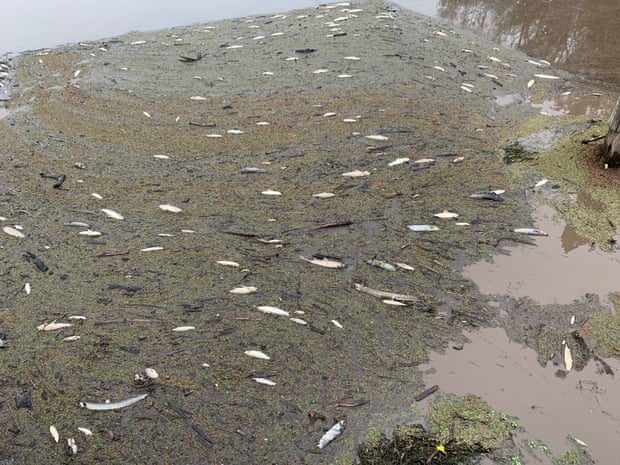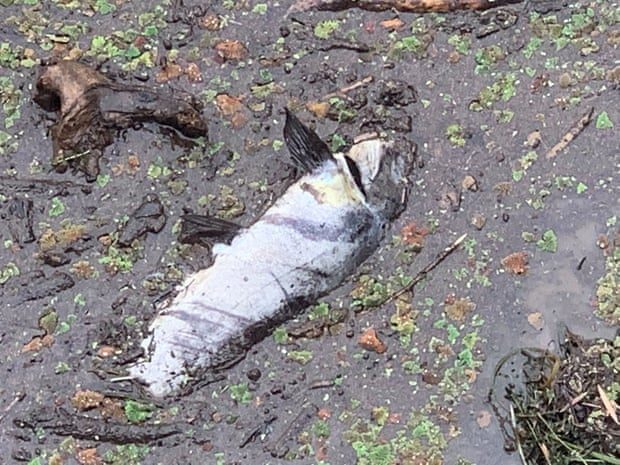
Parts of the Macleay River - favoured by recreational fishers - have been turned into what locals described as "runny cake mix" that stank of rotting vegetation and dead fish.
One freshwater ecologist told Guardian Australia the impact of the fish kill might be felt for decades to come, with long-lived species like Australian bass hit hard.
The NSW Department of Primary Industries has been receiving reports of "hundreds of thousands" of fish dead in the river since December 2019.
Locals say rain in the past 10 days has seen more ash and mud from the parched and burned landscape running into the river.
The disaster on the Macleay River is one of eight fish kills reported to the department this year, with the cause of most linked to lack of rainfall.
Larry Newberry, a recreational fisher from Frederickton, near Kempsey, said he drove 100km to George's Creek to survey the river last weekend.
"I would say from what I've seen I would not be surprised that it's wiped out every fish in at least 100 kilometres of the river," he said.
"The stench was overwhelming - it stank that much it made you heave. It's the dead fish, the rotting vegetation and the ash from the fires and maybe the fire retardant. It is just like brown sludge.
"I've been fishing the river for 50 years and I have seen fish kills before, but nothing of this magnitude. This will be happening in every east coast river that's been hit by bushfires."

Species seen dead and reported to Guardian Australia were Australian bass, eels, bullhead mullet, yellow-eye mullet, herring, gudgeons and catfish.
Upstream from Kempsey at the town of Bellbrook, residents have been using pumps and hoses borrowed from firefighters to try and oxygenate the water.
Newberry said he admired the efforts but feared it was "like pissing into a 40 kilometre an hour nor'easter".
James Pritchard, a founder of the Bellbrook Social Fishing Club, said rain on Thursday evening had raised the level of the river, but had "brought tonnes and tonnes of debris and dirt with it".
He said: "There's more ash in the river now than I've ever seen before. The top of the river is covered in ash. The water looks like a runny cake mix. It's terrible.
"The river is finished for generations - I won't see this come back in my lifetime. To say I'm fucking gutted isn't the word."
Aboriginal elders relied on a healthy river for food and to teach culture, he said, and this would devastate those efforts.
"This is so wrong. The DPI knew this was going to happen and they've put nothing in place," he said.
Prof Lee Baumgartner, a freshwater ecologist at Charles Sturt University, said the fish would have suffocated.
Adding ash and nutrients to the water promotes bacteria, which in turn removes oxygen from the water. And if the water becomes sludgy, fish are not able to pass enough water over their gills to extract oxygen.
Even though efforts to oxygenate the water might seem futile, he said even one saved mature female bass could then go on to spawn and lay hundreds and thousands of eggs.
He said there was a precedent for understanding the long-term impacts of an event such as this: major bushfires in 1939 had caused ash to run into the Lachlan River, and "the fish never recovered".
He said: "I think we'll see more of these events as it rains. These things can have decades of impact. It can be really terrible."
The department's "fish kills" page also has reports of hundreds of dead fish at Tilba Lake on the south coast of NSW, where soot had been reported on the banks, alongside dead bream, flathead, mullet, eels and blue swimmer crabs.
Drought had also likely caused the death of thousands of fish in the Hastings River near Port Macquarie, the page reports.
A NSW DPI statement said its fisheries department "continues to investigate a fish kill event on the Macleay River".
The statement said: "The suspected cause of the incident is poor water quality leading to low dissolved oxygen. Rainfall events are adding ash from the extensive bushfires throughout the region into local catchments, as well as other organic matter and sediment. This can cause rapid drops to oxygen levels in the water.
"Fisheries staff have conducted numerous field assessments and the main species affected have been Australian bass, freshwater mullet and eel-tailed catfish. The number of fish impacted is estimated to be in the hundreds of thousands."
Community members were encouraged to report fish deaths or observations to the Fishers Watch hotline on 1800 043 536.



With the obvious exceptions of aquaria, fish "farms", lakes and rivers that are "stocked", and fish/eggs that are transported in bilgewater, aren't all fish everywhere "native" fish?